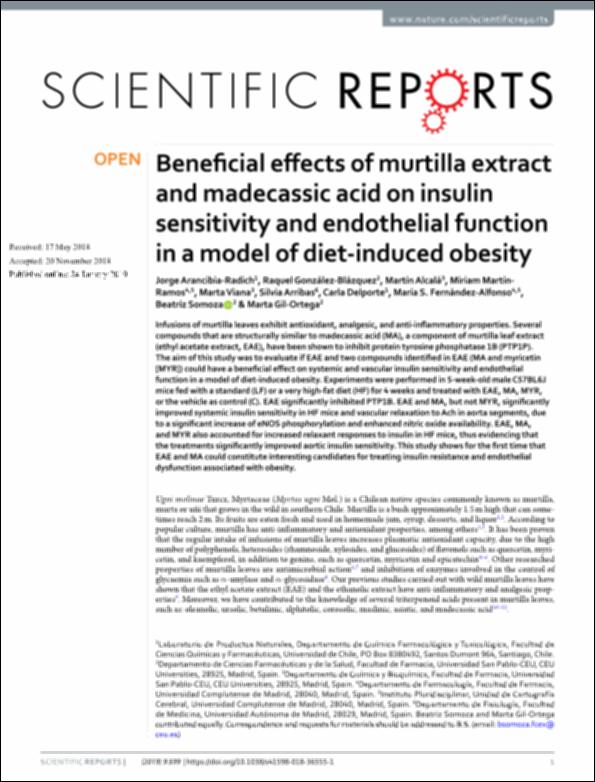Please use this identifier to cite or link to this item:
http://hdl.handle.net/10637/14501Beneficial effects of murtilla extract and madecassic acid on insulin sensitivity and endothelial function in a model of diet-induced obesity
| Title: | Beneficial effects of murtilla extract and madecassic acid on insulin sensitivity and endothelial function in a model of diet-induced obesity |
| Authors : | Arancibia-Radich, Jorge González Blázquez, Raquel Alcalá Díaz-Mor, Martín Martín Ramos, Miriam Arribas Rodríguez, Silvia Magdalena Delporte, Carla Fernández Alfonso, María Soledad Somoza Hernández, Beatriz Gil Ortega, Marta |
| Keywords: | Murtilla; Ethyl acetate extract.; Insulin sensitivity; Endothelial function.; Obesity |
| Publisher: | Nature |
| Citation: | Arancibia-Radich J, González-Blázquez R, Alcalá M, Martín-Ramos M, Viana M, Arribas S, Delporte C, Fernández-Alfonso MS, Somoza B, Gil-Ortega M. Beneficial effects of murtilla extract and madecassic acid on insulin sensitivity and endothelial function in a model of diet-induced obesity. Sci Rep. 2019 Jan 24;9(1):599. doi: 10.1038/s41598-018-36555-1. |
| Abstract: | Infusions of murtilla leaves exhibit antioxidant, analgesic, and anti-inflammatory properties. Several compounds that are structurally similar to madecassic acid (MA), a component of murtilla leaf extract (ethyl acetate extract, EAE), have been shown to inhibit protein tyrosine phosphatase 1B (PTP1P). The aim of this study was to evaluate if EAE and two compounds identified in EAE (MA and myricetin [MYR]) could have a beneficial effect on systemic and vascular insulin sensitivity and endothelial function in a model of diet-induced obesity. Experiments were performed in 5-week-old male C57BL6J mice fed with a standard (LF) or a very high-fat diet (HF) for 4 weeks and treated with EAE, MA, MYR, or the vehicle as control (C). EAE significantly inhibited PTP1B. EAE and MA, but not MYR, significantly improved systemic insulin sensitivity in HF mice and vascular relaxation to Ach in aorta segments, due to a significant increase of eNOS phosphorylation and enhanced nitric oxide availability. EAE, MA, and MYR also accounted for increased relaxant responses to insulin in HF mice, thus evidencing that the treatments significantly improved aortic insulin sensitivity. This study shows for the first time that EAE and MA could constitute interesting candidates for treating insulin resistance and endothelial dysfunction associated with obesity. |
| URI: | http://hdl.handle.net/10637/14501 |
| Rights : | http://creativecommons.org/licenses/by-nc-nd/4.0/deed.es openAccess |
| ISSN: | 2045-2322 |
| Issue Date: | 24-Jan-2019 |
| Center : | Universidad San Pablo-CEU |
| Appears in Collections: | Facultad de Farmacia |
Items in DSpace are protected by copyright, with all rights reserved, unless otherwise indicated.


